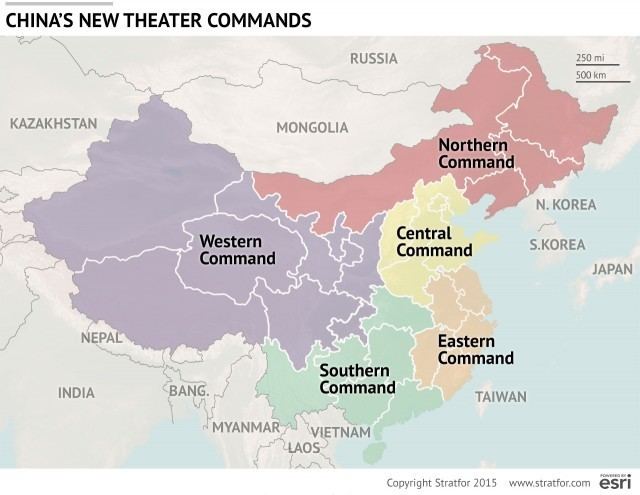Founded 2016 | ||
 | ||
Similar People's Liberation Army Gro, People's Liberation Army, People's Armed Police, People's Liberation Army Air, People's Liberation Army Navy | ||
The People's Liberation Army uses a system of theater commands, of which there are now five:
Contents
History
In December 1954, the existing six major military regions were reorganised into twelve regions: Shenyang, Beijing, Jinan, Nanjing, Guangzhou, Kunming, Wuhan (former Hubei MR) (zh:中国人民解放军武汉军区), Chengdu, Lanzhou, Tibet, Xinjiang, and Inner Mongolia. The former Northwest Military Region, which became the Beijing Military Region, doubled as Beijing-Tianjin Garrison Command. Due to the tension in the Taiwan Straits, the State Council ordered the establishment of the Fuzhou Military Region on 22 April 1956. It included the provincial military districts of Fujian and Jiangsu, formerly under the Nanjing Military Region. The Fuzhou MR was officially established on 1 July 1956, with Ye Fei as its commander and political commissar.
The thirteen military regions established by 1956 were reduced to eleven in the late 1960s. Those eleven military regions - Shenyang, Beijing, Jinan, Nanjing, Guangzhou (including Hainan Island), Kunming, Wuhan, Chengdu, Lanzhou, Xinjiang, and Fuzhou - were reduced to seven by 1985-88. From that point the active military districts included Lanzhou Military Region, incorporating the former Ürümqi Military Region, Chengdu Military Region, incorporating the former Kunming MR, Nanjing Military Region, which includes the former Fuzhou MR, Beijing Military Region, and Shenyang Military Region. Finally Guangzhou and Jinan Military Regions both appear to include parts of the former Wuhan MR.
The military regions are divided into military districts, usually contiguous with provinces, and military sub-districts.
In January 2014, Chinese senior military officers revealed that the PLA is planning to reduce the number of military regions from seven to five "military areas" to have joint command with ground, naval, air, and Second Artillery Corps forces. This is planned to change their concept of operations from primarily ground-oriented defense to mobile and coordinated movement of all services and to enhance offensive air and naval capabilities into the East China Sea. The coastal Jinan, Nanjing, and Guangzhou regions will be turned into three military areas, each with a joint operations command, for projecting power into the Yellow Sea, East China Sea, and South China Sea. The four other inland military regions will be streamlined into two military areas mainly for organizing forces for operations. The change is to occur over the next five years.
In February 2016, the seven military regions were reorganised into five theater commands, as part of the 2015 People's Republic of China military reform.
Nicknames
Each military region has a nickname commonly used by some of its affiliated organizations, especially those active in cultural areas, including, most notably, its performance troupe, as well as its own newspaper:
